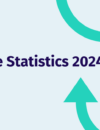
While employment rates, in general, have taken a hit over the last year, as the pandemic impacted businesses and organisations across the UK, the number of disabled people out of work is significantly more than those who are not disabled.
According to the Commons Library report, Disabled people in employment (2021), “52.3% of disabled people were in employment, down from 54.1% a year previously. The employment rate for people who are not disabled was 81.1%, down from 82.2%.”
The same report shows that the unemployment rate for disabled people has increased to 8.4% in October-December 2020; for people who are not disabled, the rate is 4.6%, and “the disability employment gap has increased over the last year from 28.1% points to 28.8 percentage points.”
It’s worth bearing in mind that these figures may be subject to change, as The Office for National Statistics (ONS) has delayed the publication of data from 2020 onwards. Once these figures have been shared, these statistics could be even more indicative of the issues disabled workers face today in the UK.
Nonetheless, this is still a clear indication that people with disabilities are less likely to find employment in the UK. But why are these unemployment rates so high?
People with disabilities are likely to be overlooked or rejected for a role for which they are applying, regardless of whether they can work to a very high standard, or are more than qualified for the role.
The inspiring story of Andrea Dalzell
One example is the story of Andrea Dalzell. Andrea is a nurse who has been working on the frontline in America during the COVID-19 pandemic. She is also disabled. Her dream of working in acute care was dashed time and time again as her disability was judged by potential employers; until the healthcare sector in the USA desperately needed as many nurses as possible to fight coronavirus.
While her abilities and skills as a nurse were still judged even after she started working on the wards, Andrea was able to prove that she was able to perform above and beyond, regardless of her disability.
The Forbes article that shares Andrea’s story also details the similar experiences of two other nurses who use wheelchairs. Their accounts not only prove that there are very few ways in which employees, particularly in healthcare, are limited by their wheelchairs, but also that they are often at an advantage, and an asset to the team. They are less likely to tire, and they can be an essential role model and comfort for patients who find themselves experiencing life-changing medical events.
In the article, Dalzell says: “I am on wheels, I am actually faster […] I’m not standing, so my legs won’t be hurting for 12 hours!
“The misconception that I won’t be able to do something is flabbergasting to me. It’s an assumption placed onto people with disabilities because they don’t necessarily move the way others do – and it’s automatically written off that it can’t be done.”
It shouldn’t take a global crisis to prove that people with disabilities are equally skilled and motivated, but this story is evidence that employees with disabilities are valuable to the organisations they work within; they just need equal opportunities.
This Forbes article also re-emphasises the discrimination disabled people face when finding work. Allison Norlian, the article’s author, writes that Dalzell found “that employers were very interested in her on paper, right up until the moment she rolled into the interview with her wheelchair.” This is, sadly, a common experience. Thomas Aichner argues in his article for Nature that the disadvantages experienced by disabled jobseekers are “mainly because of negative prejudices of employers, which often believe that people with disabilities are not able to perform as efficiently as non-disabled workers, or that they are a burden rather than a source of added value to the company.” But, in fact, the opposite is true. Rather than being a burden, people with disabilities are regularly better described as an asset; and not because they demonstrate an organisation’s inclusive ethic.
Disability is not a disadvantage
Aichner’s piece, The economic argument for hiring people with disabilities, shares several arguments for the employment of people with disabilities, beyond just ticking an ED&I box and avoiding damaging their public image or legal action.
One of his arguments is that people with disabilities are likely to be much more motivated. This is backed up by research. Since people with disabilities have likely faced more adversity in the recruitment process, successful employees may relish the opportunity once they’re hired, and will therefore put in more effort. This motivation may also be down to the desire to prove to employers and sceptics that they are equally worth investing in and proving those who are judgemental and discriminatory wrong. Higher motivation means better work; a huge plus for their employer, and fellow colleagues.
Aichner also raises the great point that some disabilities or conditions may enable employees to be even more skilled in their roles, putting them at a huge advantage. He writes: “People with Asperger’s are often intellectually gifted, have a quick grasp, high attention to detail, extreme ability to concentrate, tenacity and perseverance. These are ideal conditions for a company working with information technology […] Despite these advantages, applicants who mention their Asperger’s syndrome when applying for an accounting position receive about 26% fewer expressions of employer interest (Ameri et al., 2018).”
Another great example of ‘taking advantage’ of people’s extra needs or capabilities is the idea of recruiting them for specific roles where their disabilities don’t impact their productivity: “Computer-assisted activities, in particular, can also be performed by blind people or people with severe motor disabilities. Since they are usually also dependent on technical products in their private lives, there is often an increased interest and an above-average understanding of technology and information technology. The increasingly frequent possibility of working from home also facilitates the integration of these people into the world of work.”
Proof, then, that there really is no such thing as a disability in the workplace.
It’s not just about what benefits the employer can enjoy from employing someone with a disability: the employee will also experience satisfaction and support from the working environment. Again, Aichner points out “more than 50 studies exploring the meaning of work for people with cancer, mental illnesses, brain injuries, paraplegia, AIDS, and musculoskeletal disorders found that work continued to play a vital role in their lives, as it is perceived to be a source of identity, while providing feelings of normality, socialization, and financial support (Saunders and Nedelec, 2014)”
Employing someone with a disability or difficulty is a mutually beneficial decision. Not only does it make moral, legal and economical sense for the company, but it’s another huge step in creating a truly inclusive and equal society, and offers everyone the chance to make an impact and find satisfaction and success in their career.
Of course, some adjustments may need to be made to accommodate and welcome disabled employees, helping them to feel fully supported as they work. Flexible working hours, specialist equipment and technology, or simply making the workplace physically wheelchair and mobility friendly are all just a few examples of how companies can adapt to be truly inclusive.
No, it’s not always cheap, but it is an investment; and if accessibility, adaptation and staff wellbeing hasn’t already been budgeted for, then it’s a sign your organisation has been cutting corners when it comes to accessibility – and it’s time for that to change.





